Indian bread
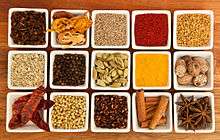 |
| This article is part of the series |
| Indian cuisine |
|---|
|
Regional cuisines
|
|
Ingredients, types of food |
|
See also
|
|
Indian breads are a wide variety of flatbreads and crêpes which are an integral part of Indian cuisine. Their variation reflects the diversity of Indian culture and food habits.
Ingredients
Most flat breads from northern India are unleavened and made primarily from milled flour, usually atta or maida, and water. Some flatbreads, especially paratha, may be stuffed with vegetables and layered with either ghee or butter.
In Maharashtra and Karnataka breads are also made from grains like jowar (Sorghum bicolor), ragi, a finger millet (scientific name: Eleuisine Coracana) and bajra or pearl millet, and is called "rotla" in Gujarat and "bhakri" in Maharashtra.
In southern India and the West Coast, most flat breads are basically crêpes made from peeled and split black lentils (urad dal) and rice. Popular varieties include dosa, Appam, uttapam and rice rotis and ragi rotis.
Most Indian breads make use of the yeast spores in the atmosphere for fermentation.
Preparation
In northern India, a dough of the main ingredient is prepared and flattened by rolling. Most Indian breads, such as roti, kulcha and chapati, are baked on tava, a griddle made from cast iron, steel or aluminum. Others such as puri and bhatura are deep-fried. The dough for these breads is usually made with less water in order to reduce oil soaked up when frying.
In Southern India, a batter of rice and black lentils is prepared and ladled in small amounts onto a hot greased skillet, where it is spread out into a thin circle and fried with oil or ghee until golden brown. In Western India (including the states of Maharashtra, Gujarat and Rajasthan) bread may be made from coarse grains such as bajra, sorghum or ragi, though wheat is the staple in these regions. The grains and/or cereals are usually milled into a fine powder, and mixed with a little water to make a smooth dough. This dough is patted into a circle by hand - either by holding it between the two hands or by placing it on an upturned plate or other flat surface.[1]
In Maharashtra a multi-grain flat-bread called "thalipeeth" is also prepared. It contains many grains and cereals like wheat, rice, bajra, jowar, ragi, Macrotyloma_uniflorum horsegram, green gram, black gram, chickpeas and so on. Each grain or cereal is roasted separately and then milled together into a fine powder. Spices and chopped onions are added along with water to make the dough, and it is patted into circles, after which it is roasted on a griddle with some ghee or oil. It is often served with home made butter.[2]
Indian breads of Central Asian origin, such as naan and tandoori roti, are baked in a tandoor. Naan is usually leavened with yeast.
Varieties
Different varieties of Indian bread include: Chapati, Phulka, Puri, Roti, Bajra Rotla, Thepla, Paratha, Naan, Kulcha, Bhatoora, Baqar Khani, Appam, Dosa, Luchi, Puran Poli, Pathiri, Parotta and many more. Some of these, like Paratha and Roti have many varieties. Some varieties depend on the kind of grain used to prepare them, and others depend on the fillings they contain.
The Appam is a fermented crepe usually prepared with finely powdered rice flour. In the South Indian state of Kerala, many varieties are made like Kallappam, Vattayappam and Palappam (Vellayappam). The kallappam is made on flat iron griddles. The vattayappam is a steamed bread, and palappam is made in small shallow bottomed pans, which are kept covered while the bread cooks. Palappam has a thin crisp lace like strip around it.
Gallery
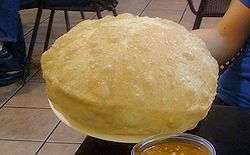
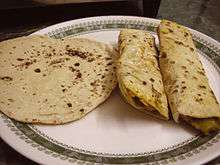
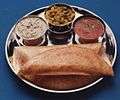

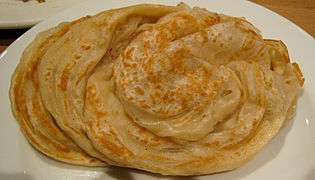
 Kulchas with choley'
Kulchas with choley'
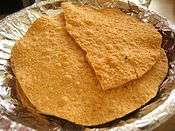

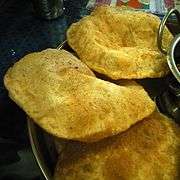
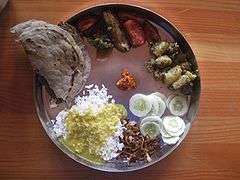


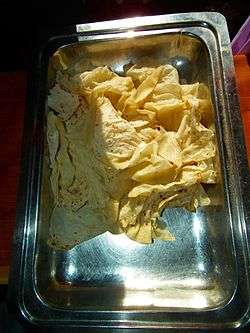
See also
References
- ↑ Thumma, Sanjay (28 August 2012). "Jowar Ki Bhakri - Roti of Sorghum flour". vahrehvah.com. Retrieved 11 March 2016.
- ↑ D'Souza, Jasmine. "Thalipeeth". Foodfood.com. Retrieved 11 March 2016.



